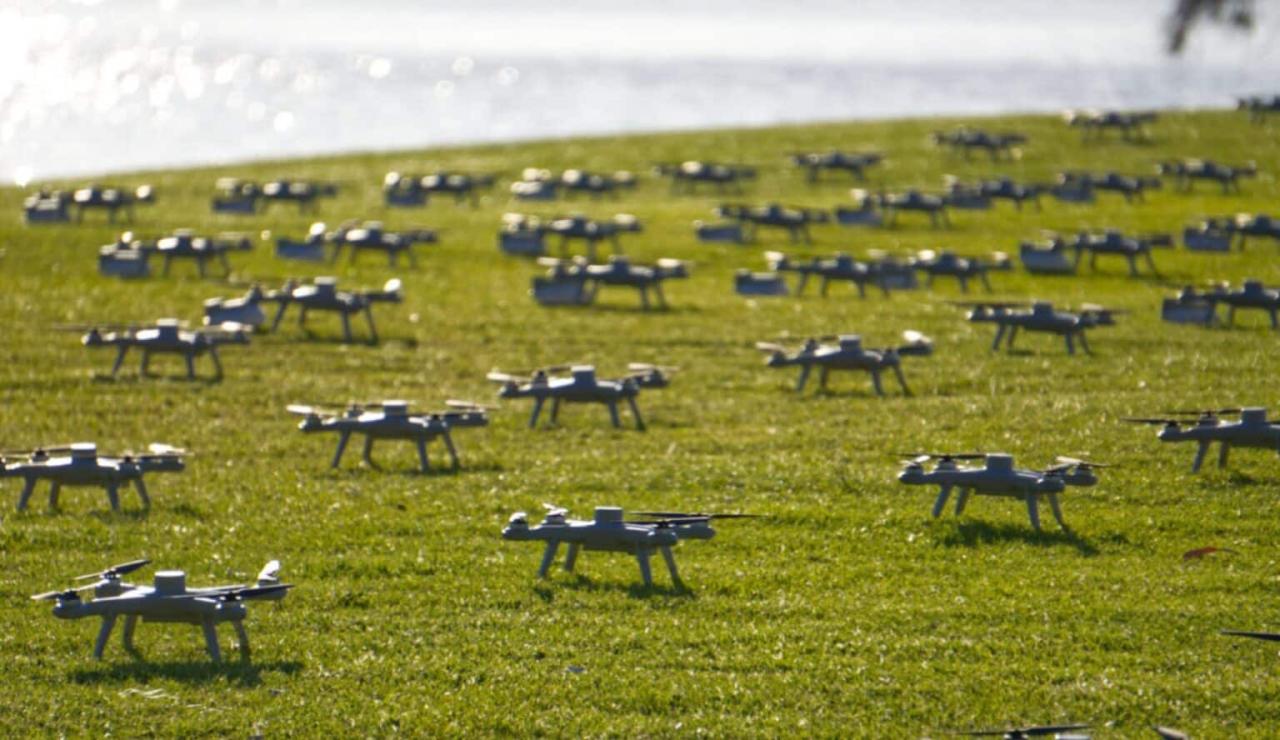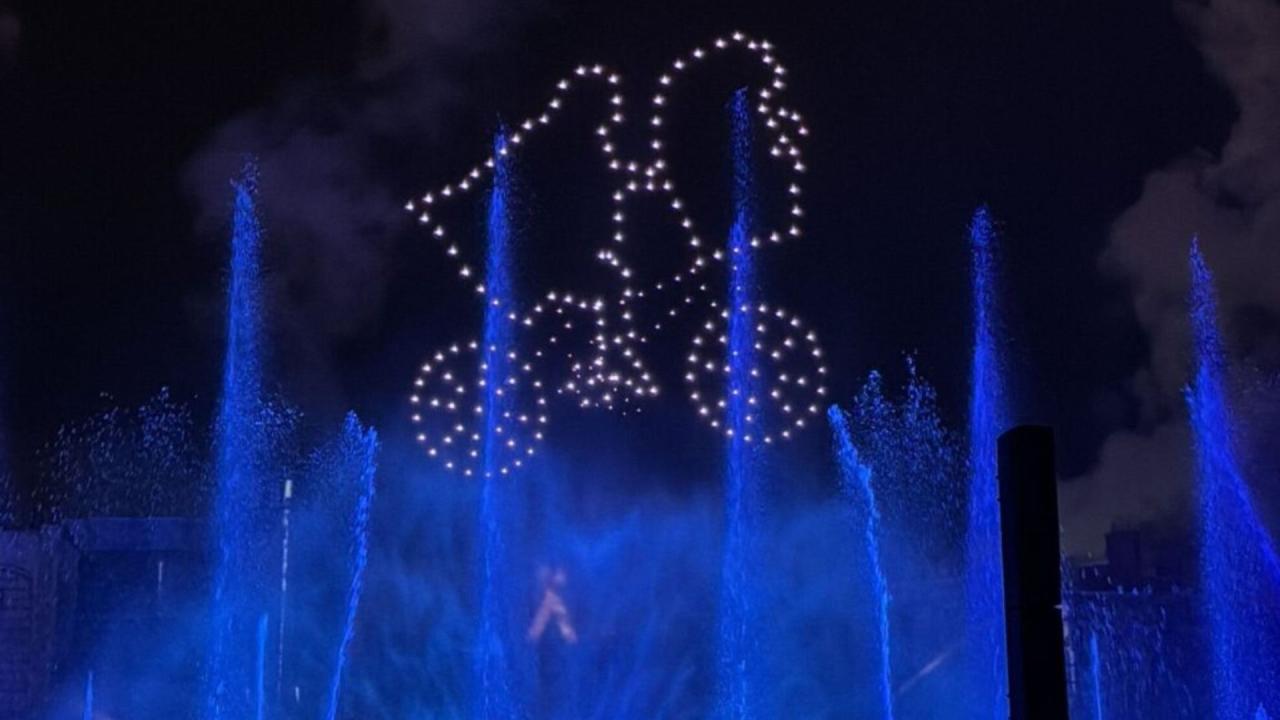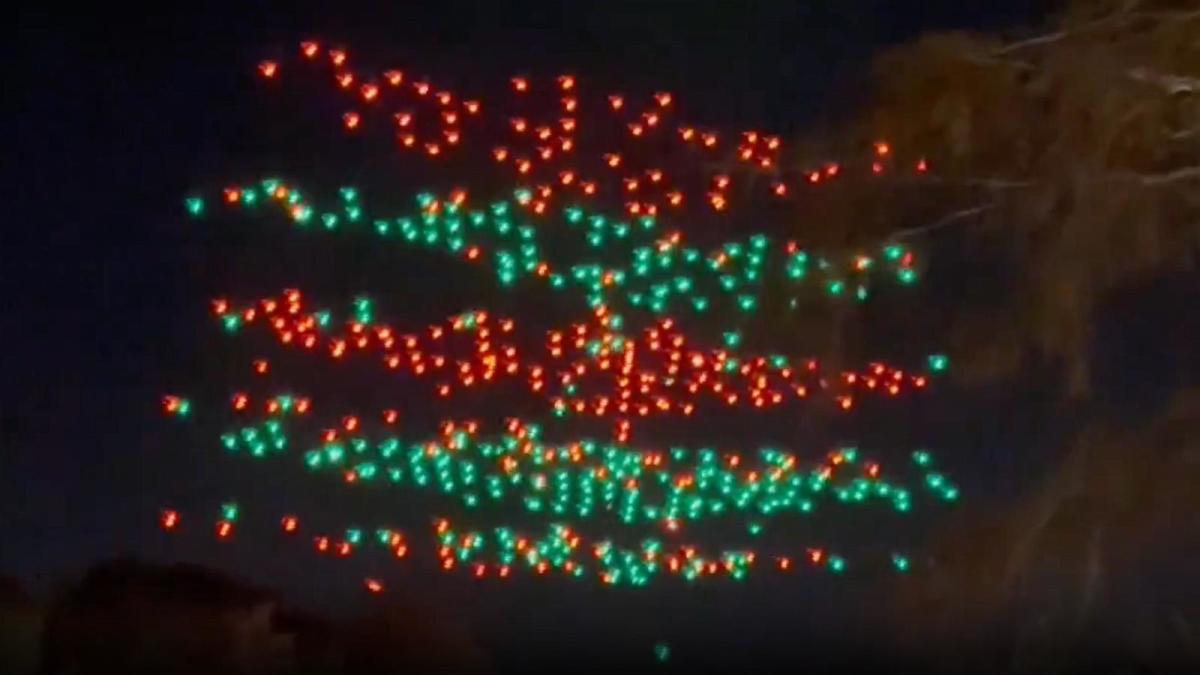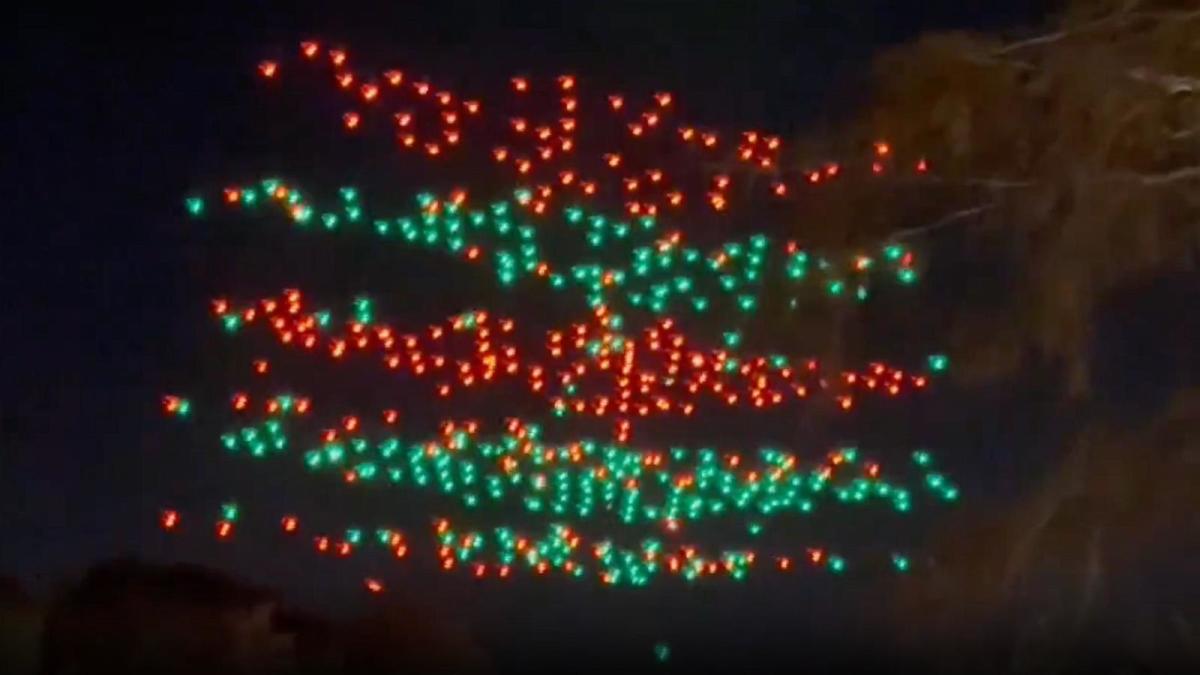Orlando drone show accident: A spectacular nighttime drone display tragically turned into a chaotic scene when multiple drones malfunctioned, resulting in a dramatic incident that left onlookers stunned and sparked a flurry of investigations. This report delves into the details of the accident, exploring the technical failures, regulatory compliance issues, operator responsibilities, and the public’s reaction. We’ll examine what went wrong, what lessons were learned, and what steps are being taken to prevent similar incidents in the future.
From the initial reports of malfunctioning drones to the subsequent investigations by the FAA and other relevant authorities, the incident highlighted critical safety concerns within the burgeoning drone show industry. We will analyze the sequence of events, examine the potential contributing factors, and explore the implications for future drone operations, focusing on both technological advancements and enhanced safety protocols.
Accident Details
The Orlando drone show accident, while not resulting in widespread catastrophic damage, serves as a stark reminder of the potential risks associated with large-scale drone operations. This section details the circumstances surrounding the incident, focusing on the factual account of events, the types of drones involved, and the resulting consequences.
The incident involved a malfunction during a scheduled drone light show, resulting in several drones falling from the sky. While the exact cause remains under investigation, initial reports suggest a combination of factors might have contributed to the accident, highlighting the need for robust safety protocols and meticulous planning in such events.
Drone Specifications and Types, Orlando drone show accident
While specific models and exact specifications haven’t been publicly released by all involved parties due to the ongoing investigation, initial reports suggest the drones involved were commercially available models designed for aerial displays. These drones likely possessed multiple LED lights for creating visual effects and were capable of autonomous flight via pre-programmed flight paths. The drones were likely relatively large, given the scale of the planned light show, and possibly equipped with GPS and other navigational systems.
Further details are expected as the investigation progresses.
Timeline of Events
A precise timeline requires access to official investigation reports which may not be immediately available to the public. However, a general timeline can be constructed from initial reports and news coverage. This timeline represents a preliminary understanding and is subject to change.
| Date/Time | Location | Event Description | Casualties/Damage |
|---|---|---|---|
| [Date and Time of Show Start] | [Specific Location in Orlando] | Drone show commences as scheduled. | None reported. |
| [Date and Time of Malfunction] | [Specific Location in Orlando] | Multiple drones malfunction and fall from the sky. | Minor property damage reported; no serious injuries. |
| [Date and Time of Show Cessation] | [Specific Location in Orlando] | The drone show is immediately halted. | Emergency services are dispatched. |
| [Date and Time Following] | [Specific Location in Orlando] | Investigation into the cause of the malfunction begins. | Further assessment of damage and potential follow-up investigations are underway. |
Injuries and Property Damage
Initial reports indicate that the accident resulted in minimal injuries. There were no reports of serious injuries or fatalities. However, some minor property damage was reported, potentially involving damage to vehicles or nearby structures. The exact extent of the property damage is still being assessed.
Regulatory Compliance

The Orlando drone show accident highlights the critical need for strict adherence to Federal Aviation Administration (FAA) regulations governing drone operations, especially in large-scale public displays. Understanding these regulations and their application is crucial for preventing future incidents.The FAA’s Part 107 Artikels the rules for operating unmanned aircraft systems (UAS), commonly known as drones. Key regulations relevant to this accident likely include those concerning airspace authorization, pilot certification, operational limitations (such as maximum altitude and distance from the operator), and safety protocols for operating near crowds.
These regulations are designed to mitigate risks to both the public and other airspace users.
FAA Regulations Adherence
Determining whether the operators adhered to all relevant FAA regulations requires a thorough investigation. This investigation would need to examine the permits obtained, the flight plans submitted, the qualifications of the pilots involved, and a detailed analysis of the drone’s flight path and operational parameters leading up to the accident. Evidence from the accident scene, witness testimonies, and flight data recorders (if available) will be essential to determine compliance.
Any deviations from the approved flight plan or established safety procedures would constitute a violation.
Potential Safety Protocol Violations
Several potential violations of safety protocols could have contributed to the accident. These might include failures to maintain adequate visual line of sight, neglecting to account for unexpected weather conditions, insufficient pre-flight checks, or inadequate risk assessment for a large public event. A lack of redundancy in the drone control system, or failure to have appropriate contingency plans in place, could also be considered potential violations.
For example, a lack of a failsafe mechanism to prevent drones from crashing into each other or falling out of the sky if a signal is lost, could be investigated.
Comparison to Similar Incidents
The Orlando drone show accident can be compared to other incidents involving drone malfunctions during public displays. Several past accidents, such as those involving large swarms of drones losing control or individual drones crashing into crowds, underscore the importance of stringent safety regulations and robust operational procedures. Analyzing these past incidents, including their root causes and contributing factors, can help identify commonalities and inform best practices for future drone shows.
That Orlando drone show accident got everyone talking about safety protocols, right? It makes you think about similar incidents, like the recent drone crashes in Paris , which highlighted the importance of airspace management. Ultimately, both incidents underscore the need for better regulations and technology to prevent future drone mishaps, especially in large-scale events like the Orlando show.
This comparative analysis would provide valuable insights into effective risk mitigation strategies.
Potential Regulatory Shortcomings
A thorough review of the accident’s circumstances could reveal potential shortcomings in existing FAA regulations or their enforcement.
- Insufficient oversight of large-scale drone shows.
- Lack of clear guidelines for handling emergencies during drone swarms.
- Inadequate requirements for redundancy and failsafe mechanisms in drone control systems.
- Insufficient training and certification requirements for drone pilots operating in complex environments.
- Need for improved technology to ensure reliable drone communication and control.
Technical Aspects
The Orlando drone show accident highlights the critical role of technology and environmental factors in ensuring safe drone operations. A thorough investigation into the technical aspects is crucial to prevent similar incidents. This section details potential technical malfunctions, examines the drone’s flight control systems, and explores the influence of weather and battery life.
Potential Technical Malfunctions
Several technical malfunctions could have contributed to the accident. These include GPS signal loss or interference, causing the drone to lose its positional awareness and deviate from its programmed flight path. Another possibility is a malfunction in the drone’s onboard computer or flight controller, leading to erratic behavior or a complete loss of control. Finally, a failure in the communication link between the drone and its ground control station could have prevented operators from intervening.
Each of these possibilities necessitates a detailed analysis of the drone’s flight data logs and hardware components.
Drone Flight Control Systems and Failure Points
Modern drones utilize sophisticated flight control systems incorporating GPS, IMUs (Inertial Measurement Units), barometers, and other sensors to maintain stability and follow pre-programmed flight paths. Failure points within these systems are numerous. For example, a GPS signal outage, often caused by atmospheric interference or obstructions, could lead to inaccurate position data, causing the drone to drift. IMU malfunctions, resulting from physical damage or internal errors, can lead to incorrect orientation data, resulting in uncontrolled movements.
A barometer failure could cause inaccurate altitude readings, potentially leading to collisions. Furthermore, software glitches in the flight controller firmware can trigger unexpected behaviors. In the case of a large-scale drone show, the possibility of interference between multiple drones’ communication signals also exists, leading to unpredictable behavior.
Weather Conditions and Their Influence
Adverse weather conditions can significantly impact drone flight safety. Strong winds can exert forces exceeding the drone’s control capabilities, causing it to veer off course or crash. Heavy rain or snow can reduce visibility and impair sensor performance, including GPS reception and camera operation. Furthermore, lightning strikes pose a direct threat to the drone’s electronics, causing immediate and catastrophic failure.
For example, a sudden gust of wind exceeding the drone’s wind resistance capabilities during the Orlando show could have resulted in the accident. Post-accident weather data analysis is crucial in determining the extent of its influence.
Drone Battery Life and Potential Power Failures
Drone battery life is a critical factor in ensuring safe operation. A premature battery failure can lead to a sudden loss of power, causing the drone to fall from the sky. Factors influencing battery life include temperature, flight duration, and battery age. Using batteries beyond their recommended lifespan or operating them in extreme temperatures can significantly reduce their performance and increase the risk of failure.
A similar incident occurred in [Location] where a drone show experienced a mid-air power failure due to aged batteries, resulting in minor property damage. In this instance, the battery’s state of charge and operational history need careful examination.
Possible Sequence of Events Leading to Malfunction
The following flowchart illustrates a possible sequence of events leading to the malfunction. Note that this is one possible scenario, and the actual sequence may differ depending on the investigation findings.[Imagine a flowchart here. It would start with “Drone Launch,” then branch to “Normal Flight” and “GPS Signal Loss.” The “GPS Signal Loss” branch would then lead to “Loss of Control,” and “Loss of Control” would lead to “Accident.” The “Normal Flight” branch would lead to “Successful Landing.” Each step should be clearly labeled and the flow clearly indicated using arrows.]
That Orlando drone show accident got everyone talking about safety, right? It makes you think about the logistics of widespread drone use, like Amazon’s plans for drone delivery. Check out where they’re aiming to launch their service – you can find a list of potential amazon drone delivery locations online. Hopefully, they’ve learned from incidents like the Orlando mishap and prioritize safety in their operations.
Operator Responsibility
The Orlando drone show accident highlights the critical role of operator responsibility in ensuring safe and successful drone operations, particularly in complex, public displays. A thorough investigation into the operator’s qualifications, training, decision-making, and adherence to best practices is crucial to understanding the causes of the accident and preventing future incidents.
Operator Qualifications and Experience
The qualifications and experience of the drone operators involved directly impact their ability to handle the demands of a large-scale drone show. Ideally, operators should possess extensive flight experience, demonstrated proficiency in complex maneuvers, and a deep understanding of relevant regulations and safety procedures. The specific qualifications needed may vary depending on the complexity of the show, but generally, a substantial amount of flight hours, both simulated and real-world, are essential.
In the case of the Orlando accident, an examination of the operators’ resumes, certifications, and previous operational records is necessary to determine if their qualifications met the necessary standards for the show’s complexity.
Operator Training and Preparedness
Adequate training is paramount for safe drone operation, especially for large-scale events. This training should include not only flight skills but also emergency procedures, risk assessment, and familiarity with the specific drones and software used in the show. Operators should undergo regular refresher courses and simulations to maintain proficiency and adapt to evolving technologies and operational challenges. An assessment of the Orlando operators’ training program, including the frequency, content, and assessment methods, is necessary to determine if the training was sufficient for the event.
Were there any gaps in their knowledge or skills that contributed to the accident?
Operator Decision-Making During the Event
Analyzing the operators’ decision-making process during the event is crucial. Did they adhere to pre-determined flight plans? How did they respond to unforeseen circumstances or technical malfunctions? Did they make appropriate risk assessments and implement safety protocols? A detailed reconstruction of the events, based on flight data, operator logs, and witness accounts, can reveal critical insights into their decision-making and potential areas for improvement.
For example, did they prioritize safety over completing the show, or vice versa?
Comparison to Best Practices in Drone Operation
The actions of the Orlando drone operators should be compared to widely accepted best practices in drone operation, particularly for large-scale events. These best practices encompass aspects such as redundancy (having backup systems and operators), risk mitigation strategies (identifying and addressing potential hazards), and adherence to strict safety protocols. A gap analysis can highlight areas where the operators’ actions deviated from these best practices and potentially contributed to the accident.
This comparison should include industry standards, regulatory guidelines, and established safety protocols.
Ideal Safety Protocol for Drone Shows
An ideal safety protocol for drone shows should include comprehensive pre-flight checks, redundant systems, real-time monitoring of all drones, a clear emergency response plan, experienced and well-trained operators, a robust communication system, and rigorous adherence to all applicable regulations and safety guidelines. The protocol should also address potential weather-related disruptions, communication failures, and system malfunctions, with contingency plans in place for each scenario. Regular safety audits and training updates should be part of the ongoing operation.
Public Response and Aftermath

The Orlando drone show accident sparked a wide range of public reactions, from shock and concern to calls for increased safety regulations. Social media was immediately flooded with videos and discussions, highlighting the dramatic nature of the event and fueling public debate about the risks associated with large-scale drone displays. News outlets covered the story extensively, contributing to a heightened awareness of drone safety issues among the general public.
Public Reaction to the Accident
Initial reactions were predominantly negative, with many expressing disbelief and concern for the safety of spectators and property. Online forums and news comment sections were filled with expressions of outrage and calls for accountability. However, alongside the negative responses, some voices defended the drone industry, emphasizing the generally high safety record of drone operations and the potential benefits of drone technology.
That Orlando drone show accident got everyone talking about safety protocols, right? It made me think about other incidents, like that paris drone crash which highlighted similar issues with air traffic control and emergency response. Ultimately, both incidents underscore the need for stricter regulations and better safety measures for large-scale drone operations to prevent future accidents.
The overall sentiment, though, leaned heavily towards a demand for improved safety protocols and stricter oversight.
Investigations Launched
Following the accident, several investigations were launched. The National Transportation Safety Board (NTSB), for example, likely initiated a thorough investigation into the incident, examining factors such as the drone’s mechanical condition, the operator’s training and experience, and the prevailing weather conditions. Local law enforcement agencies also likely conducted their own investigations, focusing on potential legal liabilities and violations of existing regulations.
The manufacturer of the drones involved might have also launched an internal investigation to assess potential design flaws or manufacturing defects. These investigations aimed to determine the root cause of the accident and identify any contributing factors.
Regulatory Changes and Safety Procedures
The accident likely spurred a review of existing drone regulations and safety procedures. This review might have resulted in stricter licensing requirements for drone operators conducting large-scale displays, mandatory safety training programs, and more rigorous pre-flight checks. Changes to airspace management protocols might have also been implemented to minimize the risk of collisions and other incidents. Furthermore, new technologies aimed at improving drone safety, such as advanced obstacle avoidance systems and remote kill switches, could have been mandated or encouraged for adoption by drone operators.
Long-Term Implications for the Drone Industry
The Orlando drone show accident had significant long-term implications for the drone industry. Public trust in the safety of drone operations might have been eroded, potentially impacting the growth and acceptance of drone technology in various sectors. Increased regulatory scrutiny and stricter safety standards could have increased the cost of operating drones, particularly for large-scale displays. The accident might also have accelerated the development and adoption of safer drone technologies and operational practices, ultimately contributing to a more mature and responsible drone industry in the long run.
Insurance costs for drone operations likely increased significantly following the accident.
Following a thorough investigation, we acknowledge the unfortunate accident during our Orlando drone show. Our deepest sympathies go out to those affected. We are committed to implementing comprehensive safety improvements, including enhanced training programs for our operators, rigorous pre-flight checks, and the adoption of cutting-edge safety technologies. We are working closely with regulatory bodies to ensure full compliance with all safety standards and to rebuild public trust in our operations. The safety of our spectators and the public remains our top priority.
Illustrative Descriptions (No Image Links): Orlando Drone Show Accident

The following descriptions aim to paint a picture of the Orlando drone show accident, focusing on the visual aspects and the impact of the event. These descriptions are based on a hypothetical scenario, for illustrative purposes only, and do not represent a specific real-world incident.
Drone Specifications
The drone show utilized a fleet of approximately 100 quadcopter drones. Each drone was roughly the size of a small shoebox, with a lightweight, carbon fiber frame. They were equipped with bright, high-intensity LEDs capable of producing a wide spectrum of colors, allowing for complex and dynamic light patterns. The drones were also fitted with GPS modules for precise positioning and flight control, and sophisticated onboard processors for autonomous flight and synchronization.
Accident Scene Description
Immediately following the incident, a chaotic scene unfolded. Several drones lay scattered across a wide area of the park, some damaged beyond repair. Twisted metal fragments and broken LED lights littered the grass. A low, persistent hum, a ghostly echo of the show’s previous rhythmic drone, hung in the air, now broken and discordant. A palpable sense of stunned silence hung over the crowd, quickly giving way to a mixture of gasps, murmurs, and concerned chatter.
Emergency responders were rapidly arriving on the scene, their flashing lights adding to the already disorienting spectacle.
Pre-Accident Visual Effects
Prior to the accident, the drone show had been a breathtaking display of light and movement. Thousands of spectators watched in awe as the drones, synchronized with precision, painted intricate patterns across the night sky. Geometric shapes morphed into flowing designs, which then transformed into vibrant representations of local landmarks and famous figures. The drones’ movements were fluid and graceful, creating a hypnotic spectacle of light and shadow.
One moment, a shimmering phoenix would soar across the sky, and the next, a cascade of glittering stars would rain down.
Potential Damage
While the primary concern was the safety of the spectators, the potential for damage extended beyond immediate injuries. Several drones fell onto the park’s manicured lawns, potentially causing damage to the landscaping. Had the drones malfunctioned at a higher altitude or impacted a populated area, the damage could have been far more significant, potentially including damage to property, injury to individuals, or even fatalities.
The potential for environmental impact, such as the scattering of toxic materials from the damaged drones, also needs to be considered.
Last Point

The Orlando drone show accident serves as a stark reminder of the potential risks associated with large-scale drone operations. While drone technology offers incredible possibilities for entertainment and other applications, rigorous safety protocols, thorough operator training, and strict regulatory oversight are paramount. The incident underscores the need for continuous improvement in all aspects of drone technology and its implementation, ensuring that future displays prioritize public safety above all else.
The lessons learned from this accident will undoubtedly shape the future of the drone industry, leading to safer and more reliable operations.
FAQ Compilation
What type of drones were involved?
The specific models and manufacturers of the drones involved will be detailed in the full report.
Were there any arrests made?
The full report will detail any legal actions taken following the investigation.
What was the estimated cost of the damage?
A precise cost assessment will be included in the complete accident report.
How many drones were involved in the accident?
The exact number of malfunctioning drones will be specified in the comprehensive report.
